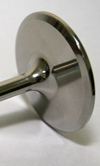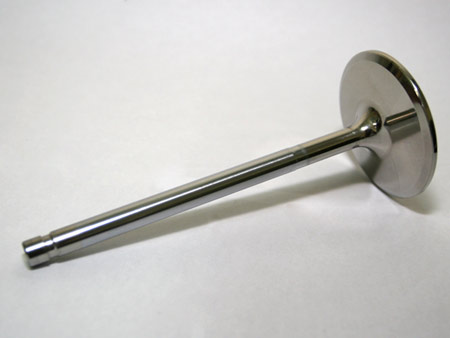Stem stiffness and seating
 In developing a race engine it is common to evolve valve-lift profiles constantly to improve the 'breathing' of the engine. The aim is to increase volumetric efficiency or, more precisely, to increased the trapped mass of fresh, unburned charge. In the case of race engines this often leads to the use of more 'aggressive' cam profiles. By 'aggression' in the case of valve-lift profiles, this means higher accelerations and the derivative of acceleration with respect to time called 'jerk' or 'pulse'. Put simply, jerk quantifies the gradient of the acceleration curve.
In developing a race engine it is common to evolve valve-lift profiles constantly to improve the 'breathing' of the engine. The aim is to increase volumetric efficiency or, more precisely, to increased the trapped mass of fresh, unburned charge. In the case of race engines this often leads to the use of more 'aggressive' cam profiles. By 'aggression' in the case of valve-lift profiles, this means higher accelerations and the derivative of acceleration with respect to time called 'jerk' or 'pulse'. Put simply, jerk quantifies the gradient of the acceleration curve.
In employing high velocity and acceleration for our valve-lift profiles, we subject the whole valvetrain to higher loads and increased levels of stress. Contact stresses are higher, and the loads in the mechanism driving the cams is also increased.
We often hear of valve control, or rather people working hard to avoid loss of valve control. Loss of valve control can encompass valve jump at the nose of the cam, where spring loads can become insufficient to maintain contact between cam and follower where the negative acceleration is too high, and there will come a limit for any cam profile where the mass of the valve and associated components and the speed of the engine conspire to overcome the available spring force. Contact is lost at this point, and this can be at or around the nose, but depending on the forces at work can be on the opening or closing flank of the camshaft.
For a given valve-lift profile that loses contact at a given speed, typical 'cures' are to increase the amount of spring load available or to decrease the mass of the reciprocating valvetrain components. Both are laudable aims, but we can go too far with both schemes. In the case of trying to decrease valve mass, people will often substitute steel materials for titanium, or move to a hollow-stem valve (or both).
It can be useful to consider the valve as a spring-mass system. The piece of the valve we are interested in controlling is the seating surface and, being part of the valve head, this is part of the mass on the end of the axially flexible valve stem. Of course, the valve head is also flexible, but the deflections in the valve head are generally low compared to the deflection of the valve head relative to the opposite end of the end of the valve, where the actuation takes place.

The valve head oscillates at the natural axial frequency of the valve. If we ignore for a moment any residual vibrations in the system, there is a strong deflection provided by the acceleration peak, which occurs just as the valve is closing. Where the stem stiffness has been markedly reduced through changing material or drilling - especially where the head mass has not been tackled to reduce mass - this deflection and the amplitude of any vibrations can mean that the valve seats prematurely. Valve lift profiles are generally designed to have a known valve seating velocity provided by a constant-velocity closing ramp. Early closure due to stem compression can mean that the valve closing ramp is not used, and high closing velocities therefore result.
Higher than expected velocity when the valve is seating can lead to valve bounce, which is literally the valve bouncing of its seat. This can have a negative effect on performance, but also poses something of a reliability risk to the valve. Other vibrations in the valvetrain can also lead to valve bounce - spring surge, for example.
It is probable that there are residual axial vibrations in the valve remaining from the initial acceleration peak when the valve opens. To remove one possible cause of valve bounce, we need to be sure we have not made the valve stem too flexible.
Fig. 1 - In order to avoid high-velocity valve seating and valve bounce, stem stiffness should not be reduced excessively in order to save mass (Courtesy of Sinus Valves)
Written by Wayne Ward